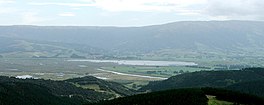| Lake Waipori | |
|---|---|
 The lake and its surrounding wetlands, seen from the hills to the southeast. The Sinclair Wetlands are to the left of the picture. | |
| Location | South Island |
| Coordinates | 45°58′S170°07′E / 45.967°S 170.117°E |
| Type | Natural freshwater lake |
| Primary inflows | Waipori River |
| Primary outflows | Waipori River |
| Basin countries | New Zealand |
| Max. length | 2.4 km (1.5 mi) |
| Max. width | 1.52 km (0.94 mi) |
Lake Waipori is the smaller and shallower of the pair of lakes located in the wetlands to the south west of Dunedin in New Zealand on the Waipori River. [1] The Waipori River is a major tributary of the Taieri River, and these wetlands form the southern edge of the Taieri Plains. [2]
The lake is inhabited by various waterfowl and wetland birds. [3] [4] It is however too shallow and inaccessible (due to being surrounded with wetlands) to allow for recreation other than fishing and duck hunting in season. [1]
It is possible to travel from the Waipori River at Berwick through the lake and through to Lake Waihola in a flat bottomed dinghy or jetboat. [5] The lake is too shallow for other forms of motorboat. [5]
The lake is bordered to the southwest by the Sinclair Wetlands. [6]
